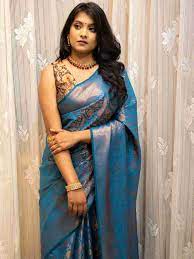Kanchipuram Silk Sarees, often referred to as Kanjivaram Pure Silk Sarees, are not just garments but woven poetry, representing the rich cultural tapestry of India. Originating from Kanchipuram, a town in Tamil Nadu known for its ancient temples and heritage, these sarees have a history as resplendent as the fabric itself. The intricate craftsmanship, vibrant colors, and luxurious texture of Kanchipuram Silk Sarees make them a cherished possession, often passed down through generations.
The Origins and History
The history of Kanchipuram Silk Sarees dates back over 400 years, rooted in the temple town of Kanchipuram, which is also known as the “Silk City”. The craft was traditionally practiced by the Devanga and Saligar weaver communities, who migrated to Kanchipuram from Andhra Pradesh in the 15th century under the patronage of the Vijayanagara kings. These weavers brought with them the expertise in weaving silk and intricate patterns that are still evident in Kanchipuram sarees today.
The Weaving Process
Creating a Kanchipuram Silk Saree is a labor-intensive process that involves multiple stages, each requiring meticulous attention to detail and skilled craftsmanship. The process begins with the selection of the finest mulberry silk threads, which are then dyed in vibrant hues. The dyeing process itself is an art, as achieving the perfect shade requires experience and precision.
Once dyed, the threads are carefully dried and wound onto bobbins, ready to be woven. The weaving process is traditionally done on handlooms, which allows for the intricate designs that Kanchipuram sarees are known for. The body and the border of the saree are often woven separately and then joined together with a technique called korvai, making the join invisible and ensuring the saree’s durability.
One of the most distinctive features of a Kanchipuram Silk Saree is its contrasting borders and pallu (the end piece of the saree). These are usually adorned with rich zari work, made from gold or silver-coated threads, which add to the saree’s opulence. The motifs used in Kanchipuram sarees often draw inspiration from South Indian temples, palaces, and natural elements like peacocks and flowers, adding to their cultural significance.
The Cultural Significance
Kanchipuram Silk Sarees hold a special place in Indian culture, particularly in South India. They are an integral part of weddings and festive occasions, symbolizing purity, prosperity, and elegance. A bride draped in a Kanjivaram Pure Silk Saree is a common sight in South Indian weddings, where the saree’s richness and intricate designs add to the grandeur of the occasion.
These sarees are also popular gifts, signifying respect and admiration. They are often handed down as heirlooms, with each saree carrying stories and memories of the women who wore them. The durability and timeless beauty of Kanchipuram Silk Sarees make them a valuable addition to any wardrobe.
Modern Adaptations and Global Appeal
While Kanchipuram Silk Sarees have maintained their traditional essence, they have also adapted to contemporary fashion trends. Designers experiment with new motifs, color combinations, and weaving techniques to cater to modern tastes while preserving the saree’s traditional charm. These adaptations have widened the appeal of Kanchipuram sarees, making them popular not just in India but across the globe.
Celebrities and fashion icons have also played a significant role in popularizing Kanjivaram Pure Silk Sarees internationally. Their appearances in these sarees at high-profile events have showcased the elegance and versatility of Kanchipuram sarees, bringing them to the attention of a global audience.
Challenges and Preservation
Despite their popularity, the craft of weaving Kanchipuram Silk Sarees faces several challenges. The labor-intensive process, coupled with the competition from machine-made sarees, has made it difficult for traditional weavers to sustain their livelihood. The rising cost of raw materials, especially the gold and silver used in zari, also poses a significant challenge.
Efforts are being made to preserve this rich heritage. Government initiatives, cooperative societies, and non-profit organizations are working towards providing financial support, training, and better market access to the weavers. By supporting these initiatives and choosing authentic Kanchipuram Silk Sarees, consumers can contribute to the preservation of this exquisite craft.
Conclusion
Kanchipuram Silk Sarees, or Kanjivaram Pure Silk Sarees, are a testament to the rich cultural heritage and exceptional craftsmanship of India. Each saree is a work of art, woven with passion and precision, reflecting the traditions and stories of the weavers. As we drape ourselves in these luxurious fabrics, we carry forward a legacy that has been cherished for centuries. By understanding and appreciating the craft of Kanchipuram Silk Sarees, we not only celebrate their beauty but also contribute to the preservation of an invaluable cultural treasure.




